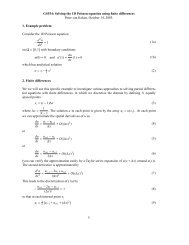Quantitative paleoenvironmental and paleoclimatic reconstruction ...
Quantitative paleoenvironmental and paleoclimatic reconstruction ...
Quantitative paleoenvironmental and paleoclimatic reconstruction ...
Create successful ePaper yourself
Turn your PDF publications into a flip-book with our unique Google optimized e-Paper software.
ARTICLE IN PRESS<br />
N.D. Sheldon, N.J. Tabor / Earth-Science Reviews xxx (2009) xxx–xxx<br />
39<br />
δ 18 O <strong>and</strong> δD values of altered bentonites from Cortijo de Archidona<br />
(Southeastern Spain) ranged from 21.0 to 23.0‰ <strong>and</strong> − 87 to −102‰,<br />
respectively, which corresponds to temperatures of crystallization<br />
ranging from 9±3 °C to 21±3 °C. In their assessment of clay minerals<br />
in an Upper Triassic paleosol profile derived from basalt, Tabor <strong>and</strong><br />
others (2004a) measured smectite δ 18 O <strong>and</strong> δD values ranging from<br />
14.5 to 15.6‰ <strong>and</strong> −78 to −71‰, respectively. This range of smectite<br />
δ 18 O <strong>and</strong> δD values corresponds to temperatures of crystallization<br />
ranging from 49 to 57 °C. Such temperatures are far too high for<br />
soil formation, <strong>and</strong> were interpreted to result from hydrothermal<br />
alteration.<br />
Tabor <strong>and</strong> Montañez (2005) adopted a similar approach to that of<br />
Delgado <strong>and</strong> Reyes (1996) in order to estimate temperature of smectite<br />
crystallization for smectite <strong>and</strong> kaolinite mixtures in Upper Pennsylvanian<br />
<strong>and</strong> Lower Permian paleosols from Texas, U.S.A. Notable<br />
differences between the approach of Tabor <strong>and</strong> Montañez (2005)<br />
<strong>and</strong> Delgado <strong>and</strong> Reyes (1996) are (1) analysis of only the b0.2 μm<br />
fraction of phyllosilicate <strong>and</strong> (2) consideration of the variability of<br />
oxygen <strong>and</strong> hydrogen isotope fractionation between smectite <strong>and</strong><br />
water that is related to differences in the chemical composition of<br />
smectite. The range of δ 18 O <strong>and</strong> δD values corresponds to temperatures<br />
of phyllosilicate crystallization ranging from 22±3 °C to 35±3 °C,<br />
where phyllosilicate δ 18 O <strong>and</strong> δD values from Upper Pennsylvanian<br />
paleosol profiles indicated significantly lower temperatures than δ 18 O<br />
<strong>and</strong> δD values from Lower Permian paleosol profiles.<br />
Vitali et al. (2002) analyzed the b0.2 μm of mixed-mineral<br />
phyllosilicate fraction from a middle Cenomanian paleosol profile in the<br />
Dunvegan fm., British Columbia, Canada. Measured δ 18 O<strong>and</strong>δD values<br />
ranged from −12.9‰ to −11.6‰ <strong>and</strong> −93‰ to −81‰, respectively, <strong>and</strong><br />
were interpreted to correspond to paleotemperatures of phyllosilicate<br />
crystallization ranging from 9 to 16 °C. To date, very few studies have<br />
focused upon the δ 18 O<strong>and</strong>δD values of soil <strong>and</strong> paleosol smectites <strong>and</strong><br />
other common pedogenic minerals such as gibbsite <strong>and</strong> related<br />
aluminum hydroxides (Bird <strong>and</strong> Chivas, 1989; Vitali et al., 2000, 2001)<br />
<strong>and</strong> illite (Yeh, 1980; Capuano, 1992; Gilg, 2003; Hyeong <strong>and</strong> Capuano,<br />
2004). Nevertheless, these hydroxylated pedogenic minerals are very<br />
common mineral products of pedogenic weathering, <strong>and</strong> these minerals<br />
have the potential to become important proxies of paleotemperature<br />
throughout much of the terrestrial Phanerozoic stratigraphic record.<br />
7.5.3.3. Kaolinite. Much work has been done with the oxygen <strong>and</strong><br />
hydrogen isotope compositions of soil-formed kaolinites (Sheppard,<br />
1977; Hassanipak <strong>and</strong> Eslinger, 1985; Bird <strong>and</strong> Chivas, 1988a,b, 1989;<br />
Lawrence <strong>and</strong> Rashkes Meaux, 1993; Savin <strong>and</strong> Hsieh, 1998; Girard<br />
<strong>and</strong> Savin, 1996; Giral-Kacmarcík et al., 1989; Girard et al., 2000). The<br />
oxygen <strong>and</strong> hydrogen isotope kaolinite-water fractionation equations<br />
(Sheppard <strong>and</strong> Gilg, 1996) in conjunction with the equation for the<br />
meteoric water line of Craig (1961) relates the measured δ 18 O <strong>and</strong> δD<br />
of kaolinite to temperature of crystallization:<br />
○<br />
T<br />
ð KÞ = 3:04×10 6 !1<br />
2<br />
δ 18 O k −0:125×δD k +7:04<br />
ð62Þ<br />
As discussed earlier, only kaolinite samples from paleosol profiles<br />
with δ 18 O <strong>and</strong> δD values that plot within the WESD <strong>and</strong> MSD should<br />
be considered viable paleotemperature proxies. For the following<br />
discussion, we also limit the dataset of kaolinite δ 18 O <strong>and</strong> δD values to<br />
only those samples that are known to have formed within the timeframe<br />
of an individual Epoch or less in the Cenozoic. Cretaceous<br />
samples are limited to Campanian or younger kaolinites. This culling<br />
of the literature data leaves 78 kaolinite samples, which are plotted<br />
with respect to their corresponding paleolatitude of soil formation in<br />
Fig. 22.<br />
Several observations may be made from this dataset (Fig. 22).<br />
(1) The mid-latitudes, from ~35 to 50° N <strong>and</strong> ~30 to 62° S, are the<br />
only locations with published, pre-Pliocene kaolinite δ 18 O <strong>and</strong> δD<br />
values. However, pedogenic kaolinite formation surely formed at<br />
lower latitude tropical sites (e.g., Wilson, 1999; Jacobs et al., 2005).<br />
Therefore, more attention should be given to determination of kaolinite<br />
δ 18 O <strong>and</strong> δD values, as well as other potential geochemical proxy<br />
data of paleotemperature, from low-latitude sites in the future.<br />
(2) Kaolinite δ 18 O <strong>and</strong> δD values indicate their warmest mean<br />
temperatures (24 °C) during Cretaceous <strong>and</strong> Eocene time, followed by<br />
Paleocene (22 °C), <strong>and</strong> their lowest mean temperatures (20 °C) during<br />
Oligocene <strong>and</strong> Miocene time.<br />
(3) Kaolinite δ 18 O <strong>and</strong> δD values correspond to crystallization<br />
temperatures that are significantly (N3 °C) higher than mean annual<br />
surface-air temperatures at modern isolatitudinal sites. Because of the<br />
large thermal-mass of soil compared to atmosphere, subsurface<br />
temperatures are generally assumed to be approximately equivalent to<br />
that of mean annual temperature (+1 to 2 °C) with little or no seasonal<br />
change in temperature (e.g., Cerling <strong>and</strong> Quade, 1993; Buol et al., 2003).<br />
Therefore, isotope values of pedogenic isotope compositions are<br />
assumed to approximately record mean annual surface air temperatures<br />
in most studies (Yapp, 2000; Tabor, 2007; Tabor <strong>and</strong> Montañez, 2005;<br />
Tabor <strong>and</strong> Yapp, 2005c). Yet, long-term monitoring of ground <strong>and</strong> air<br />
temperatures from mid-latitude sites indicates that subsurface soil<br />
temperatures are strongly correlated with surface air temperatures, <strong>and</strong><br />
vary seasonally, from ~0° to 22 °C, at 1.0 m depth (Bartlett et al., 2006).<br />
The rate of chemical weathering, <strong>and</strong> of crystallization of pedogenic<br />
minerals, is strongly temperature dependent. Furthermore, crystallization<br />
of soil minerals likely will not occur at 0 °C, as liquid water is<br />
necessary for chemical reaction. Therefore, it is possible that strikingly<br />
warm temperatures indicated by kaolinite δ 18 O<strong>and</strong>δD values in Fig. 22<br />
more accurately reflect surface-air temperatures during warm-months<br />
<strong>and</strong> growing seasons, <strong>and</strong> thus should not be compared with modern<br />
mean annual surface air-temperatures.<br />
Note that mean annual surface air temperatures in low-latitude<br />
tropical sites do not vary annually by more than 1 or 2 °C. Therefore<br />
soil subsurface temperatures do not vary by more than 1 or 2 °C, <strong>and</strong><br />
pedogenic mineral δ 18 O <strong>and</strong> δD values from those sites likely provide<br />
a reasonable approximation of surface air temperatures. However, it is<br />
possible that perennially warm conditions, similar to those in the<br />
modern tropics, existed at higher mid-latitude sites during early<br />
Neogene, Paleogene <strong>and</strong> Late Cretaceous. This reflects both that<br />
paleosol profiles (Van Houten, 1961, 1982; Dury, 1971; Tardy et al.,<br />
1990a,b) <strong>and</strong> fossil floras (e.g., Dorf, 1964) that are indicative of<br />
modern, low-latitude tropical, sites (~15° N <strong>and</strong> S) occurred at<br />
paleolatitudes as high as 60°N. Furthermore, marine paleotemperature<br />
indicators suggest that mid-latitude surface oceans were significantly<br />
warmer, as high as 30 °C, during intervals of the Paleogene<br />
<strong>and</strong> Late Cretaceous (e.g., Takashima et al., 2006). In this regard,<br />
paleosol kaolinite δ 18 O <strong>and</strong> δD values, <strong>and</strong> paleotemperature estimates<br />
shown in Fig. 22, may provide reasonable estimates of mean<br />
annual surface air paleotemperatures.<br />
Future work of this sort should seek to (1) collect kaolinite δ 18 O<br />
<strong>and</strong> δD values for paleotemperature estimates from places <strong>and</strong> times<br />
that are poorly represented in Fig. 22, (2) produce similar databases<br />
of δ 18 O <strong>and</strong> δD value with other common hydroxylated pedogenic<br />
minerals, <strong>and</strong> (3) if these paleotemperatures are correct, evaluate<br />
what mechanisms (such as atmospheric pCO 2 , ocean <strong>and</strong> atmospheric<br />
circulation, etc.) might contribute to such high temperatures in the<br />
mid-latitudes.<br />
A major limitation to the application of single-mineral paleothermometers<br />
from soils <strong>and</strong> paleosols is the requisite assumption of<br />
chemical equilibrium with water δ 18 O <strong>and</strong> δD values that lie upon the<br />
meteoric water line of Craig (1961). Changes in the position of the<br />
MWL (in hydrogen vs. oxygen isotope space) might have occurred at<br />
times during the geological past. The slope of the meteoric water line<br />
Please cite this article as: Sheldon, N.D., Tabor, N.J., <strong>Quantitative</strong> <strong>paleoenvironmental</strong> <strong>and</strong> <strong>paleoclimatic</strong> <strong>reconstruction</strong> using paleosols, Earth-<br />
Science Reviews (2009), doi:10.1016/j.earscirev.2009.03.004















